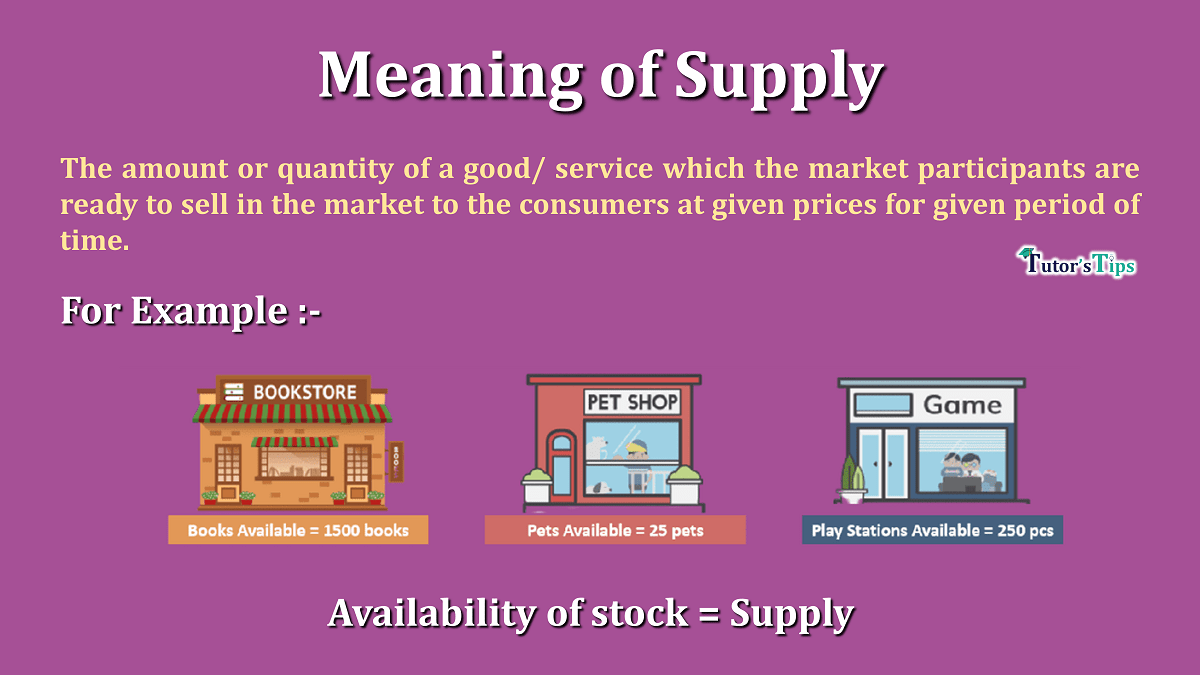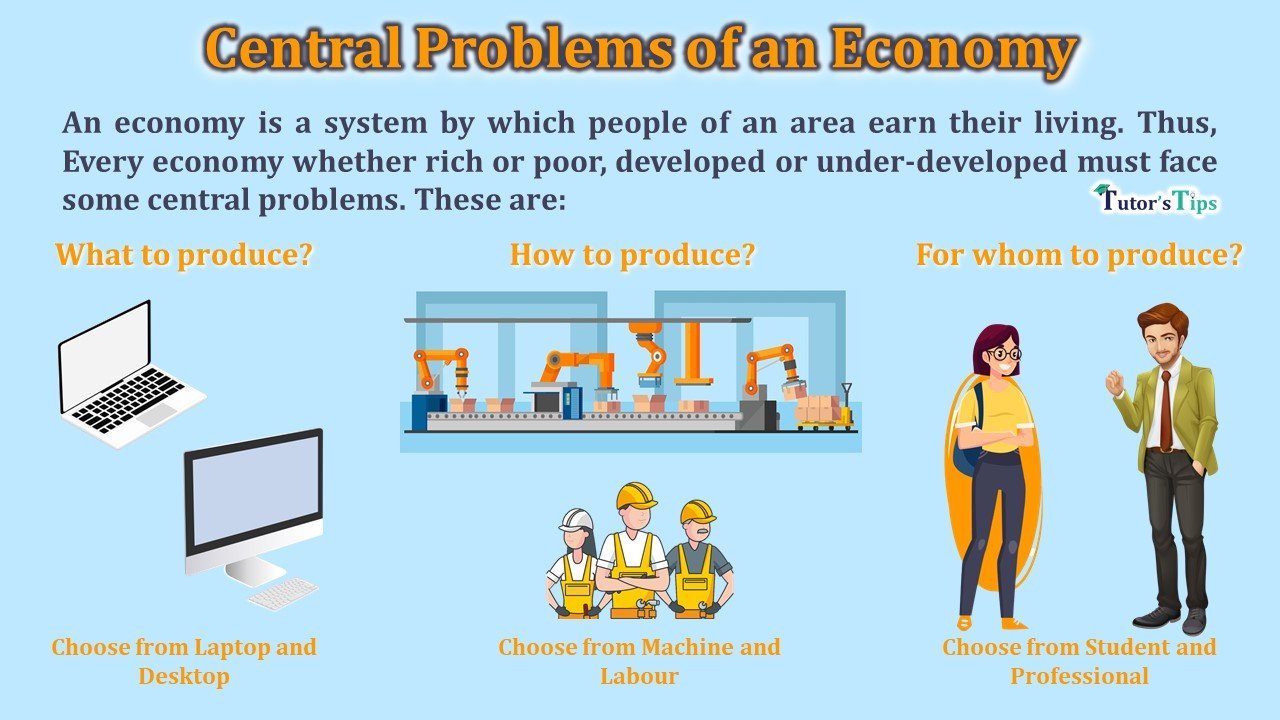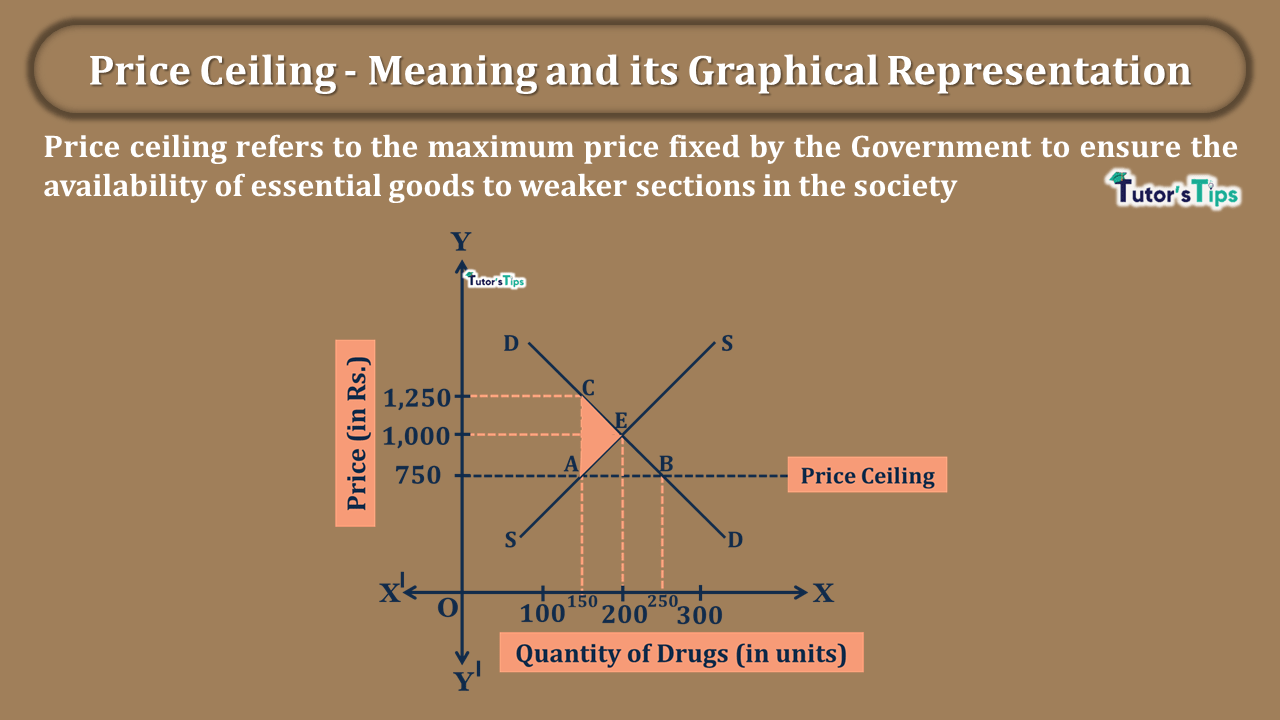Demand and Supply are the two main concepts of business economics. As we know the demand is the total amount of commodity at which consumers are willing and able to purchase it whereas supply refers to the quantity of good or services the sellers are ready to sell. In this article, we will understand the meaning of supply and its determinants.
Meaning of supply in economics:
Meaning of supply refers to that amount or quantity of a good/ service which the market participants are ready to sell in the market to the consumers at given prices for a given period of time.
A commodity can be said as supplied when
- it is ready to sell in the market but not yet sold.
- it is related to a given period of time.
According to Thomas,
“The supply of goods is the quantity offered for sale in a given market at a given time at various prices.”
Example of the meaning of Supply:
A book Seller has 70 books of Business Economics for class 11th and 80 books of the same subject for class 12th at his shop and he is ready to sell them. So the total supply of the material is equal to 150(70+80) books.
Determinants of Supply:
It refers to the factors which influence the supply of a particular commodity during a given period of time. These factors directly or indirectly affect the supply of a commodity in the market. This can be written as :
This is the function of
Qs = f( P, R, F, E, T )
where,
Advertisement-X
- Qs denotes Quantity Supplied
- f denotes function
- P denotes the price of the commodity
- R denotes the price of related commodities
- F denotes the price of factors of production
- E denotes the expectations of sellers
- T denotes the technology
Besides these, there are some other factors that affect the supply of a commodity :
- Taxation And Subsidies
- Number of Sellers
- Other Factors like the goal of firm, competition, transportation conditions and natural conditions etc
These factors derive the supply of the commodities and also, growth of the economy providing other things remain the same. the organization should understand the impact of these determinants of supply. Some of these are explained as under :
Price of the Commodity:
It is the most important determinant. It affects the supply at a large extent. As per the law of supply, there is a positive relationship between the price of a commodity and supply. The supply of a commodity increases with a rise in price, assuming other things constant, and vice versa.
For Example,
Suppose, the price of mangoes in the market rise up, the customers declines their purchasing as a result, the demand goes down which leads to the increase in the supply of mangoes in the market.
Price of Related Goods :
Supply of a good or service is affected by the price of related goods. these related goods include :
a)Substitute Goods:
Substitute goods are those which can be used in place of each other giving equal satisfaction to the consumers e.g. wheat and rice, tea and coffee etc. There is an indirect relationship between the price of substitute goods and supply of the given commodity, other things being constant and vice versa. It implies that as the price of substitute goods increases, the supply of given commodity starts declining.
For Example,
Coke and Pepsi are subsitute goods to each other. So, If the price of coke rises, it will result in more supply of coke as it becomes expensive for the consumers to buy coke instead of Pepsi. Thus, more demand of Pepsi due to less price of Pepsi as compared to price of coke results fall in the supply of Pepsi.
b) Joint Products:
Joint products are those which are produced from a single production process to satisfy the needs of consumers e.g. production of butter and cheese from milk, different grades of wood and tree etc. There is a direct relationship between the price of joint products and the supply of the given commodity, other things remain the same and vice versa. It implies that as the price of joint products increases, the supply of given commodity starts increasing.
For Example,
We produce chease and butter from milk, if the price of cheese and butter increases, there would be less demand which results in more supply cheese and butter in the market. further, the supply of milk will also increase due to low demand joint products.
Advertisement-X
Price of Factors of Production:
The cost of production depends on various factors like :
- Land
- Labour
- Capital
The incraese in the price of any of above factor results incearse in the cost of production of given commodity which will increases the price of given commodity and demand of commodity will fall. So in last there would be more supply of the given commodity in the market.
Expectations of Sellers :
If the price of a commodity is expected to rise in future, the producers prefer to withhold more with them to benefit from higher prices in future, reducing the supply now. For Example, if it is expected that the price of wheat is going to rise, the farmers would retain their agricultural production with them to get benefit from the high price in future, lowering the supply now.
Similarly, if there is an expectation that the prices are going to fall in the near future, the suppliers would increase the supply now to eliminate losses in future. Thus, price expectations also make a significant impact on the supply by the suppliers.
Technology :
Improvement in technology like technological innovations and inventions enables more efficient and better quality of production of goods and services. if Improvement in technology brings increase in the production of the given commodity at the cheaper pirce. then on the situtation of less price of the commodity the demand for the commodity will increases in result the supply of the commodity will fall and vice versa. Thus, the state of technology increases or decreases the supply of particular products.
Taxation and Subsidies :
The government policy also affects the supply of commodity at a large extent. The commodity taxes like excise duty, import duties and GST etc. imposed by the government. The the rate of taxes increased by the government in result the increase in the price of commodity. Hence, the increase in price of commodity will lower the demand of commodity and increase the supply of the given commodity. Similarly, the effect of the subsidies is opposite on the prices, demand and supply of the commodity.
Number of Sellers:
The number of sellers affects the market supply. As market supply is defined as the sum of the supply of each individual supplier, thus, more and more sellers entering the market leads to more supply. Similarly, departing the market leads to less supply in the market.
Other Factors :
There are many other factors which affect the supply of goods and services like the goal of the firm, infrastructural facilities including transportation and communication services, market structure and other factors etc.
Thanks!!!
Please share with your friends
Advertisement-X
Comment if you have any question.
References:
Introductory Microeconomics – Class 11 – CBSE (2020-21)







2 Comments